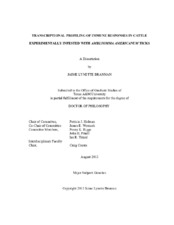| dc.description.abstract | Infestation of cattle by Lone Star ticks, Amblyomma americanum, leads to damage of hides intended for leather, weight loss, infertility, and potentially death of cattle, which contribute to production losses for farmers. Public concerns regarding chemical residues in food and the environment necessitate development of chemical-free alternative tick controls, such as breeding for tick-resistant phenotypes and developing anti-tick vaccines. Thus, the goal of this study was elucidation of mechanisms that mediate immune responses in cattle infested with A. americanum using gene expression techniques.
Methods for isolation of total RNA from bovine tick bite-site biopsies and blood leukocytes were optimized to provide RNA suitable for gene expression studies. Tick bite-site biopsies (6 mm) and blood leukocytes were collected from a total of 13 calves (N=6, Group 4 and N=7, Group 5 calves) during experimental tick infestations to determine A. americanum tick-susceptible and -resistant phenotypes. Microarray experiments compared gene expression in tick bite-sites from tick-susceptible, moderately tick-resistant, and highly tick-resistant calves. A total of 35 genes were profiled in tick bite-site biopsies and 12 genes were evaluated in blood leukocytes via gene-specific qRT-PCR assays, and analyzed for each phenotype and for each group of calves as a whole.
Analysis of microarray data revealed differential expression of IL-1R-mediators among the three cattle phenotypes. Expression profiles generated by qRT-PCR for TLR-mediating genes such as TLR2, TLR4, CD14, and MyD88 suggest that a MyD88-dependent signaling pathway may mediate the development of acquired immunity in cattle infested with Lone Star ticks. Additionally, increased expression for IL12, IFNgamma, and TNFalpha suggests that a Th1-type cell-mediated reaction may be activated, whereas increased expression of IL6, IL10, and IGHG1 supports the involvement of a Th2-type humoral-mediated response at tick bite-sites in cattle infested with at A. americanum. Regression analyses identified strong correlations between factors involved in pattern recognition in tick bite-site biopsies, including associations between TLR4 and IL1alpha, and between IL1alpha and IL1RN. In conclusion, this dissertation reports optimal methodology for gene expression studies in tick-infested cattle and provides preliminary data concerning the underlying mechanisms associated with the immune response in Lone Star tick-infested cattle. | en |


